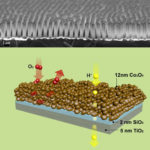
Heinz Frei, a senior scientist in Biosciences’ Molecular Biophysics and Integrated Bioimaging (MBIB) Division, seeks to engineer devices that emulate photosynthesis – the sunlight-driven chemical reaction that green plants and algae use to convert carbon dioxide (CO2) into cellular fuel. If the necessary technology could be refined past theoretical models and lab-scale prototypes, this idea, known as artificial photosynthesis, has the potential to generate large sources of completely renewable energy using the surplus CO2 in our atmosphere.

Frei’s team has developed an artificial photosynthesis system, comprised of nanosized tubes, that appears capable of performing all the key steps of the fuel-generating reaction. Their latest paper, published in Advanced Functional Materials, demonstrates that their design allows for the rapid flow of protons from the interior space of the tube, where they are generated from splitting water molecules, to the outside, where they combine with CO2 and electrons to form the fuel. Fast proton flow is essential for efficiently harnessing sunlight energy to form a fuel.
The individual unit of the system will be small square “solar fuel tiles” (several inches on a side) containing billions of the nanoscale tubes sandwiched between a floor and ceiling of thin, slightly flexible silicate, with the tube openings piercing through these covers.
“These protons easily flow through to the outer layer, where they combine with carbon dioxide to form carbon monoxide now – and methanol in a future step – in a process enabled by a catalyst supported by the titanium dioxide layer,” said Won Jun Jo, a postdoctoral fellow and first author of the paper. “The fuel gathers in the space between tubes, and can be easily drained out for collection.”
The middle layer of the tube wall keeps the oxygen produced from water oxidation in the interior of the tube, and blocks the carbon dioxide and the evolving fuel molecules on the outside from permeating into the interior, separating the two incompatible chemical reaction zones. This design mimics actual living photosynthetic cells, which separate oxidation and reduction reactions with organic membrane compartments inside the chloroplast.
Read more in the Berkeley Lab News Center.



